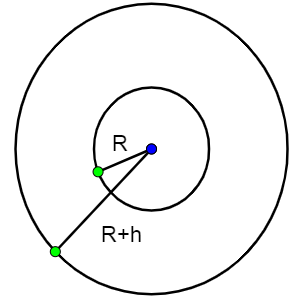Question
Question: A satellite is launched in the equatorial plane in such a way that it can transmit signals upto \(60...
A satellite is launched in the equatorial plane in such a way that it can transmit signals upto 60∘ latitude on the earth. Then the angular velocity of the satellite is:
A. 8R3GM
B. 2R3GM
C. 4R3GM
D. 8R333GM
Solution
The question is from the chapter ‘Gravitation’ and can be solved by using the formula of the time period of the satellite in an orbit. Angular velocity of a body is inversely related to its time period.
Formula used:
Formula for the time period of a revolving object:
T=2πGMr3
The angular velocity is related to time period as:
ω=T2π
Complete answer:
Given:
The range of the satellite: 60∘ latitude of earth.
The orbital time period of a satellite orbiting in earth's orbit, at a height of r=R+h is given as:
T=2πGMr3

The angular velocity is given as:
ω=T2π
We require finding the height r of the satellite.
If we consider the fact that 60∘ latitude of earth is nothing but Rtan60∘. This is the range, with R being the radius of earth. The range satellite, for the point where it is at a height h above the equatorial plane :
Range= (R+h)2−h2
Thus, in our case
R31= (R+h)2−h2
3R2=2Rh+h2
By solving, this quadratic equation, we get:
h=−R±32R
Thus, using the formula for time period now,
r=R+h;
r=32R
T=2πGM(2R/3)3
Thus the angular velocity is obtained as
ω=2πGM(2R/3)32π
8R333GM
So, the correct answer is “Option D”.
Additional Information:
A satellite is a body that revolves around other bodies like planets. Geostationary satellites have their period of revolution the same as the rotation period of the earth. Thus, geostationary satellites appear at the same position in the sky.
Note:
The formula for T was derived using circular orbit approximation for the case of satellites. The centripetal force of the satellite in its circular motion is balanced by the gravitational force that earth exerts on it.
